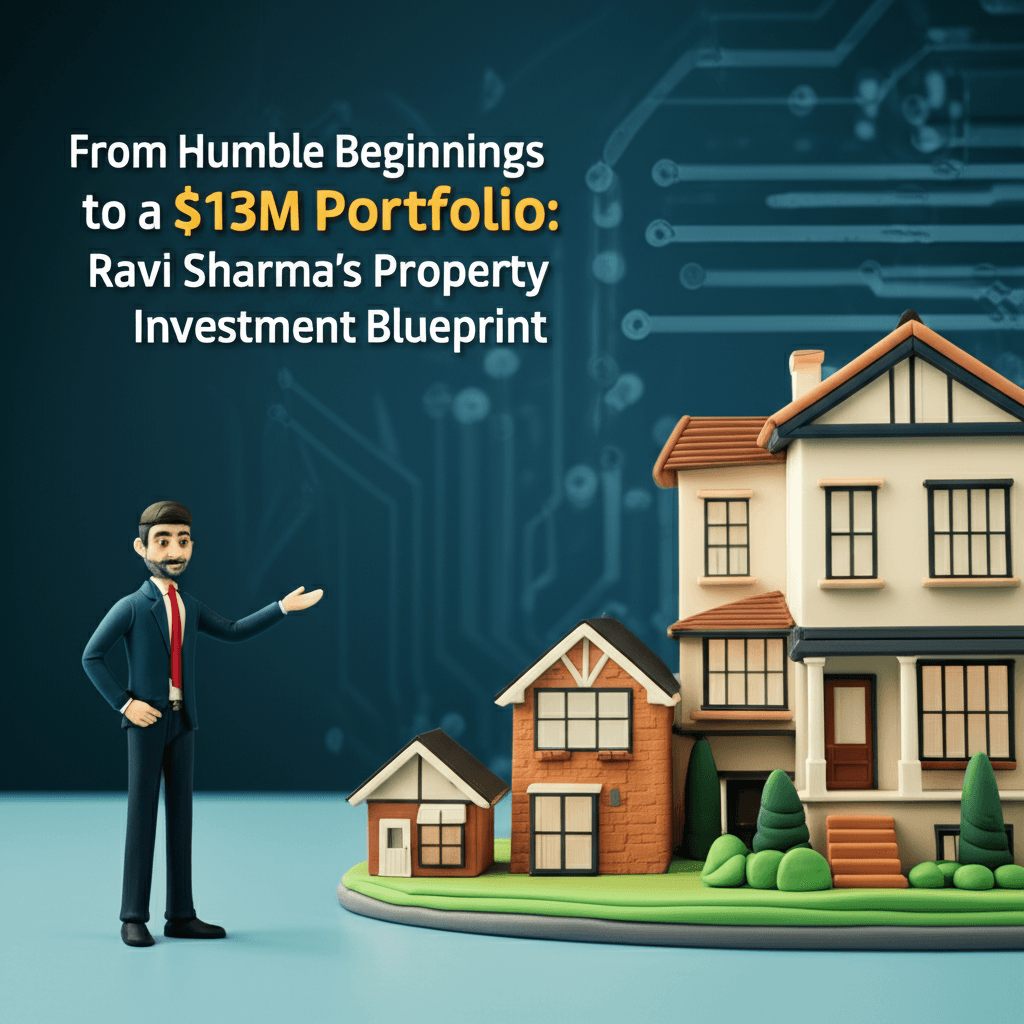From Humble Beginnings to a $13M Portfolio: Ravi Sharma's Property Investment Blueprint
Discover the core lessons in mindset, cash flow, and strategy that built a real estate empire, and learn how data can guide your own journey to success.

Introduction
What does it take to build a property portfolio worth over $13 million? For investor and entrepreneur Ravi Sharma, the journey started not in a boardroom, but in a three-bedroom house shared by four families. His story is a powerful testament to how a resilient mindset, strategic thinking, and a disciplined approach can transform humble beginnings into massive financial success. By unpacking Ravi's key lessons, aspiring investors can find a blueprint for their own path to financial freedom, grounded in principles that stand the test of time.
The Foundations of a Multi-Million Dollar Mindset
Ravi’s understanding of money was shaped early by observing the financial stress around him. Growing up with a “migrant mentality” focused on saving and hard work, he saw his father take on multiple jobs to support the family. This experience didn't breed resentment; instead, it instilled a deep-seated drive to create a life of choice and financial security. He learned that financial success wasn't about luck, but about discipline and a powerful self-belief. This core conviction—that he could achieve his goals through dedication—was something he tested and proved to himself repeatedly, from excelling in school to avoid a fast-food job to later navigating the complexities of real estate. This foundational mindset is crucial for any investor looking to build long-term wealth.
Lesson 1: Forge Your Own Path, Don't Follow the Herd
One of the most significant lessons from Ravi's early career was the importance of independent, data-driven thinking. While his peers were buying units in Sydney for around $400,000, Ravi listened to his father's experience and looked elsewhere. He chose to purchase a house in a regional area three hours from Sydney for just $250,000. The logic was simple: a freestanding house had better long-term fundamentals than a unit, and the lower entry price made it a less risky, more sustainable investment. By ignoring the popular trend and focusing on the numbers, he secured an asset with greater potential. This contrarian approach highlights the value of using deep market insights over following mainstream advice. To make similar informed decisions, it’s essential to leverage comprehensive tools for suburb and property comparison.

Lesson 2: Cash Flow is King for Sustainable Growth
Ravi quickly realized that the popular strategy of chasing capital growth in blue-chip areas often came with significant negative cash flow. Holding just two such properties could cripple his finances and lifestyle, preventing him from travelling and enjoying his 20s. His father’s core philosophy was to “hold as many assets for as long as possible,” and Ravi understood this was only feasible with strong cash flow. His regional house, renting for nearly $300 a week, was almost self-sufficient. This focus on cash flow not only protected his personal finances but also built a stable foundation that allowed him to continue acquiring more properties. Prioritizing assets that support themselves is the key to building a scalable and resilient portfolio. Understanding the intricate balance between yield and growth is where powerful real estate data analytics becomes indispensable.

Lesson 3: The Power of Self-Belief and Calculated Risk
Fear often paralyses new investors. Ravi overcame this with a simple yet profound piece of advice from his father about a worst-case scenario: “If you buy well and the cash flow is not that bad, you’ll be able to hold it for at least a couple of years... and if you struggle, just sell it.” This reframed risk as something manageable. That lightbulb moment, combined with his cultivated self-belief, empowered him to act decisively. He knew he was educated and resourceful enough to handle challenges, like finding a new job if needed. This mindset—understanding the realistic worst-case scenario and trusting your ability to navigate it—turns fear into calculated confidence. For investors who need support building this confidence, services like an AI Buyer's Agent can provide the guidance and data to demystify the process and validate decisions.
Conclusion
Ravi Sharma's journey from a crowded family home to a $13 million portfolio wasn't built on shortcuts or market fads. It was forged through a powerful combination of a resilient mindset, a willingness to defy conventional wisdom, and an unwavering focus on the fundamental principles of cash flow and long-term holding. His story teaches us that success in property investing is not just about what you buy, but why you buy and the strategic discipline you apply. By defining your goals, trusting the data, and building your own self-belief, you can create a robust strategy to achieve your own version of financial freedom.
Ready to build your property portfolio with the same strategic focus? Explore HouseSeeker's Real Estate Analytics to uncover high-growth, cash-flow-positive opportunities today.
Frequently Asked Questions
What is the most important first step for a new property investor?
According to Ravi's journey, the most crucial first step is to define your 'why' and your North Star. Understand your long-term goals, whether it's a specific passive income figure or a desired lifestyle. This clarity will guide your strategy and keep you motivated through challenges.
Should I focus on capital growth or cash flow?
A balanced approach is ideal, but Ravi's story emphasizes that strong cash flow is the engine for sustainable portfolio growth. Positive or neutral cash flow allows you to hold assets through market cycles without financial strain, which is essential for realizing long-term capital growth. It enables you to acquire more properties without sacrificing your lifestyle.
How did Ravi's mindset contribute to his success?
Ravi's success was built on a foundation of strong self-belief and a commitment to taking control of his destiny. He learned from his parents' work ethic, trusted his own analysis over herd mentality, and viewed challenges as manageable risks. This proactive, solution-oriented mindset gave him the confidence to make bold decisions and stay the course.
